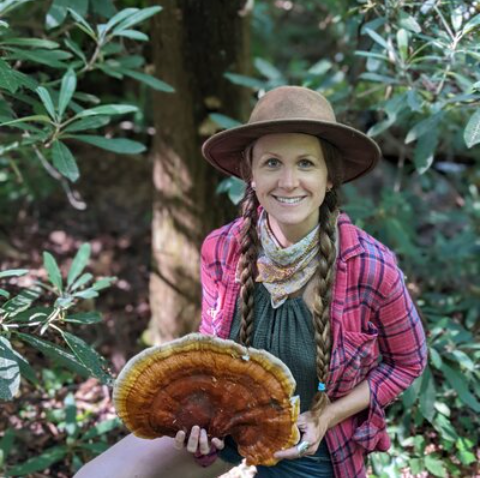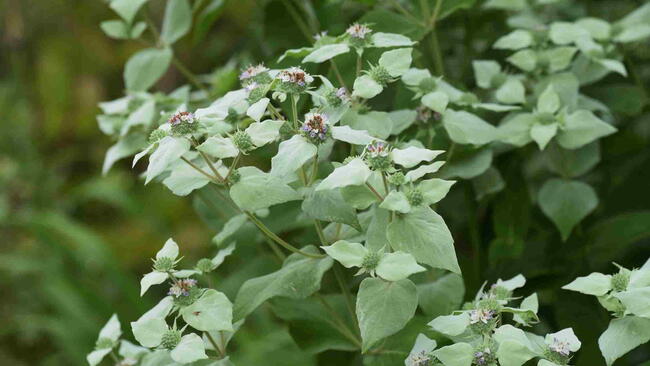We’re betting many of you have ground ivy in your yard or garden. This unassuming plant appears in early spring, along with the dandelions. While often considered an invasive weed, ground ivy is a perennial herb with an often-forgotten culinary and medicinal history! Learn about the many uses and benefits of ground ivy.
What is Ground Ivy?
Ground ivy (Glechoma Hederacea) is a perennial groundcover plant in the mint family (Lamiaceae). It grows throughout North America, temperate Europe, and Asia. Early European settlers brought her to North America, where she has now naturalized.
The common name is misleading because it is not true ivy. However, the plant has many other names, such as creeping Charlie and gill-go-by-the-ground.
While this herb can be invasive, it benefits humans and pollinators alike. Like many so-called garden weeds, it is medicinal! It has been used for centuries to treat colds, asthma, bronchitis, gastric diseases, diabetes, and inflammation.

Ground ivy’s purple blooms blanket areas of our land here at Wild Moon Acres. Because of her carpet-like nature, she is often cursed as she creeps into the garden, covering the ground and crowding out other plants.
How to Identify Ground Ivy
Ground ivy is a creeping ground cover that emerges in the spring, growing along the edges of walkways, roads, and parking lots, but it’s just as common to find it growing among the grass in your yard.
- Ground ivy has a square and slightly hairy stem, with its leaves growing opposite each other.
- The leaves are heart-shaped and scalloped.
- The tiny, edible flowers are a purple-to-sometimes-pinkish hue and grow in clumps of one to three.
- You will often see butterflies and pollinators on her purple flowers, which tells you she is an important food for our beloved winged garden friends.
- This herb has a mild flavor; its aroma is minty, almost lemony.

Similar Herbs
There are a couple of similar herbs that are commonly mistaken for ground ivy:
- Purple Dead Nettle (Lamium purpureum): This fun herb pops up in spring along with ground ivy. It has medicinal properties, and it is quite beautiful. Purple dead nettle will grow taller than ground ivy. Its leaves have a softer feel and are more deeply scalloped.
- Henbit (Lamium amplexicaule) is also in the mint family (kissing cousins to ground ivy!). The plant is an annual weed with square stems and a strong mint odor. The leaves are smaller than ground ivy and scalloped leaves; the flowers are purplish.
See pictures of these look-alikes.
Harvesting Ground Ivy
To harvest ground ivy, I trim her with my scissors or clippers, getting both leaves and flowers. The whole plant is edible.
To dry, I lay out the fresh herb on a dehydrator tray and dehydrate at a very low temperature. She also air-dries nicely in a dark, cool, dry room.
Culinary Uses
Ground ivy has been used for centuries as a culinary herb; remember, it’s edible and is from the mint family.
Before hops became our go-to herb to brew beer, ground ivy and other herbs were used to clarify and flavor beer. Served with the beer were sprigs of fresh leaves fried in batter with salt and olives. The fresh young leaves were often dried and used as a healthy seasoning for meats, soups, and vegetable dishes.
I like to sprinkle a bit of ground ivy flowers and leaves over a fresh salad.
In my Medicine Woman Program, I teach how to save the dried ground ivy for tea and vinegar and, basically, layer medicine into cooked dishes. To start, rinse this fresh herb and steep it in hot water. Add it to the teapot when head colds come around and noses are dripping!
Medicinal Uses and Benefits
Ground ivy appears in the spring with two other “weeds” that have health benefits: dandelions and wild violets.
As soon as the ivy pokes its head up from the lawn and garden, I harvest it and dry it for tea throughout the year. This is especially handy during cold and flu season.
Ground ivy is long known in traditional medicine for its many health benefits. We grow so many foods for health, yet we ignore this most common edible plant because we only see it as a “weed.” Ground ivy is said to …
- Act as an expectorant, moving mucus from the lungs, such as in respiratory infections
- Relieve congestion and inflammation of mucous membranes
- Offer antiviral and anti-inflammatory properties
- Help with hot-damp bronchitis and hot-damp pneumonia when there is persistent coughing.
- Help with congestive headaches and help clear a fever; leaves can be ground into snuff and stuffed into the nostrils to relieve headaches.
- Help those who experience hay fever and seasonal allergies
- Treat tinnitus or ringing in the ears
- Help clear congestion in the abdominal area and treat griping pains, wind, and colic
- Have diuretic and antiseptic properties, making her a lovely helper for the bladder and urinary tract; help reduce fluid retention and clear toxins; is used to treat cystitis, urinary frequency, and urinary tract infections
- Be useful when the bile flow is insufficient, helping with fat digestion and nausea that can accompany gallbladder dysfunction
- Help address chronic low-grade diarrhea and the gas and bloating that often come along with this issue
- Be an ally for active children (and adults) who play outside and come home with bumps and bruises. It can also be a poultice for sprains, bruises, scrapes, scratches, and insect bites. This would not be my first herb of choice, as there are others with more potency, but if ground ivy is all you can access, it’s worth a try. (Witch hazel is an amazing first-aid plant, as is aloe vera!)
- Provide a rich source of potassium and calcium, according to a study published by the NIH (National Library of Medicine. Potassium intake contributes to a reduction in blood pressure and, thus, reduces the risk of stroke and coronary heart disease. It also possesses a protective effect on age-related bone loss and reduces kidney stones. Calcium has been designated as a “super nutrient” due to its role in reducing the risk of osteoporosis, hypertension, and possibly colon cancer, as well as other disorders.
- Be a significant source of Vitamin C
Do you have ground ivy on your property? Let us know what you think of its culinary and medicinal uses.












Comments